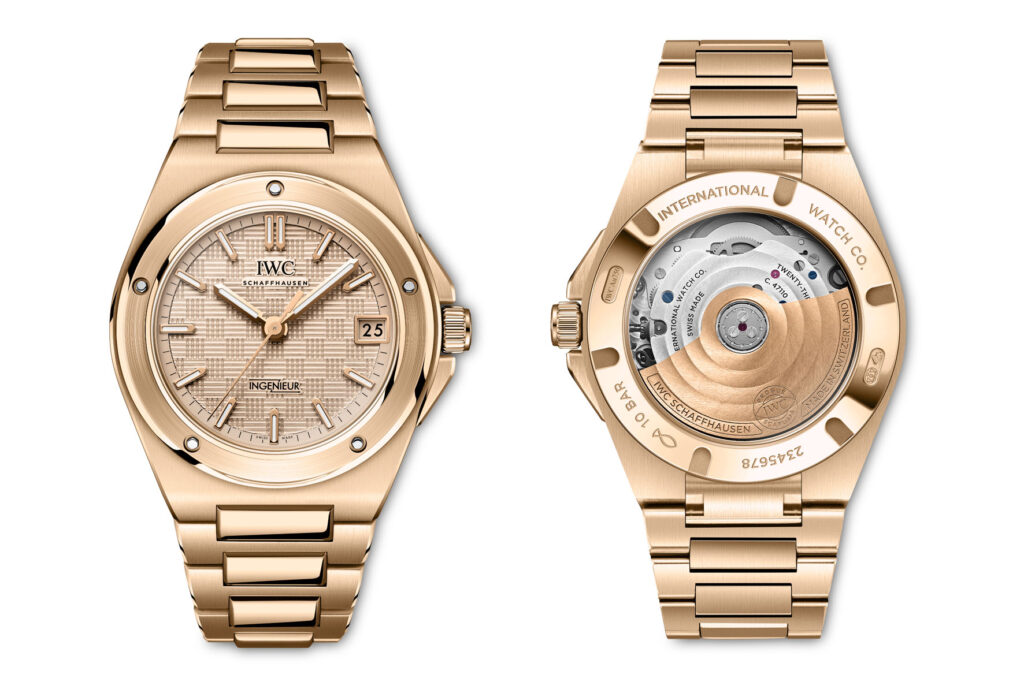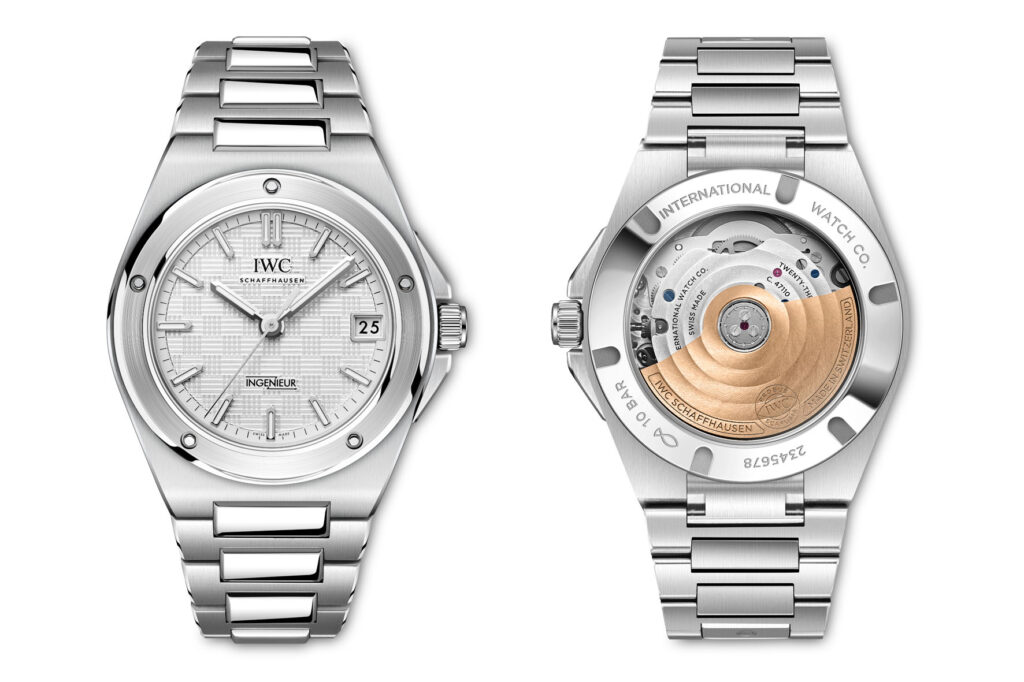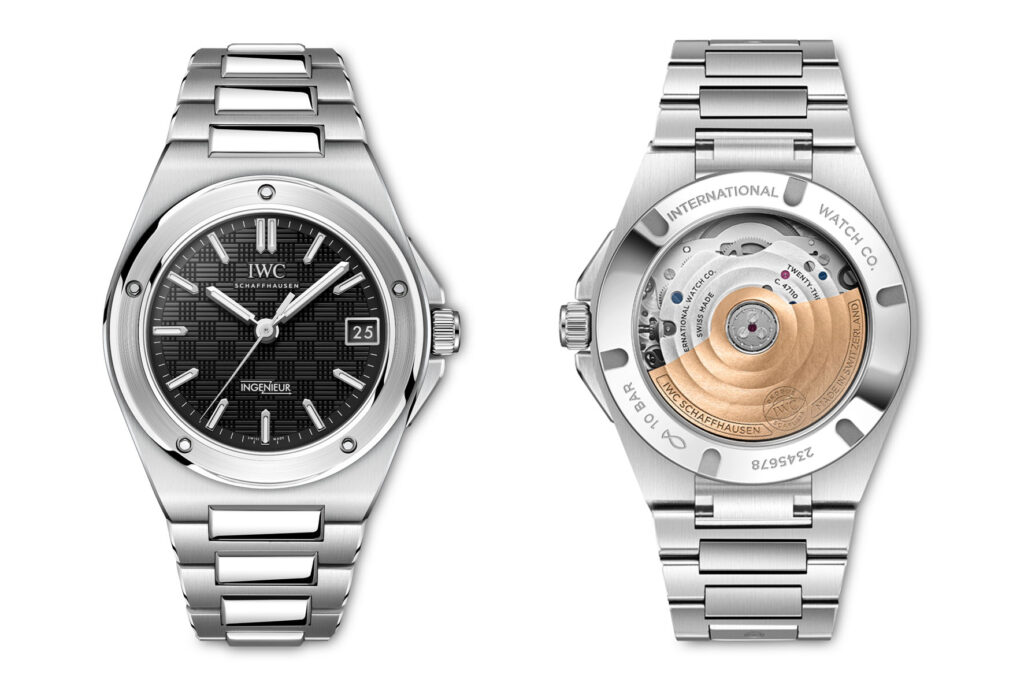IWC Schaffhausen: 7 New Ingenieur
1 April 2025Once again and after just two years, IWC Schaffhausen is putting the Ingenieur collection in the spotlight at Watches and Wonders Geneva. In 2023, the Schaffhausen-based brand had presented one of its historic lines in Geneva – updated in terms of aesthetics compared to the models of recent years – with an inspiration leaning more toward the Ingenieur SL reference 1832 designed in the 1970s by Gerald Genta. In the references presented two years ago at the show, particular attention was paid to the dials’ crafted finishing, whose ‘Grid’ motif also evoked the historical references.
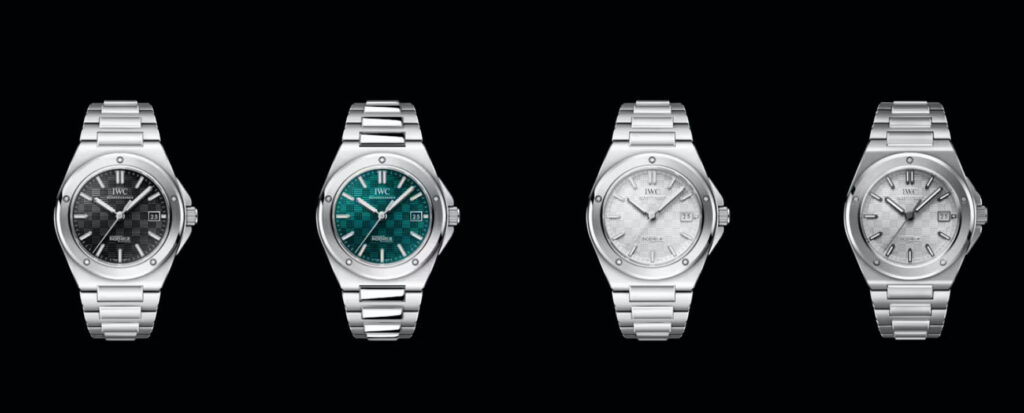
We won’t retrace the Ingenieur’s history here, which we have briefly covered in this article. Likewise, you can dig more details about the titanium version and the one with the blue dial – the former presented at the 2023 show, the latter in 2024. We will focus here on the new additions to the collection that was just unveiled at Watches and Wonders Geneva 2025, which are many and varied, but all with one common trait: the ever-higher positioning of the Ingenieur line within the IWC Schaffhausen range.
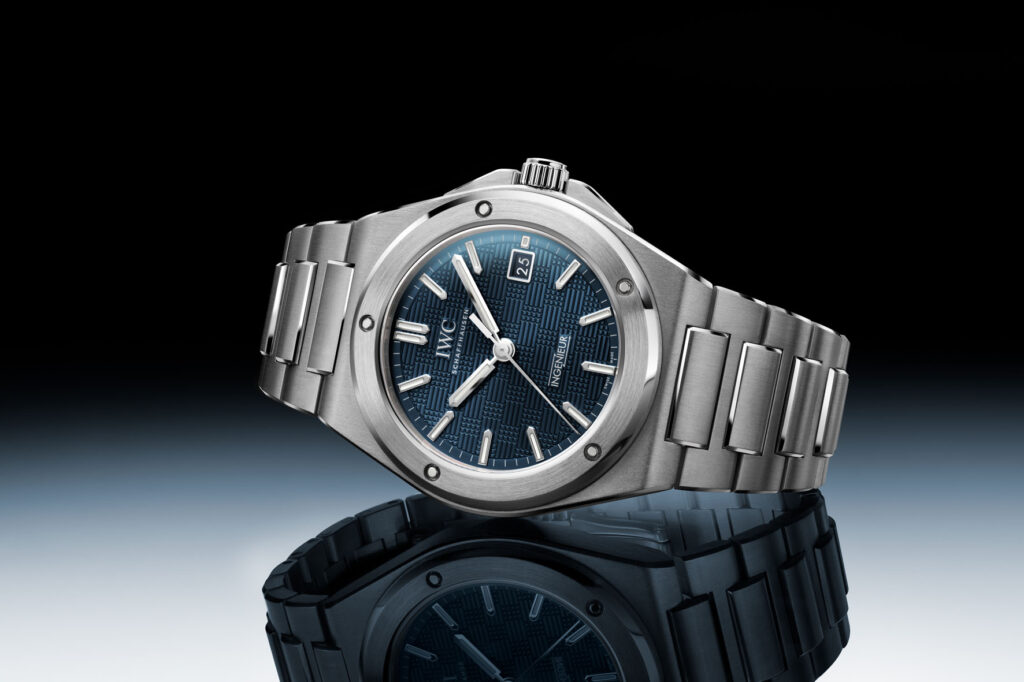
INGENIEUR AUTOMATIC 40 5N GOLD
It is a new iteration of the 40 mm case model introduced in 2023, of which it retains the high ergonomics and finish standards. IWC Schaffhausen now completes the collection with this Ingenieur Automatic 40 made entirely of 5N 18-carat gold, the material used for the case and casing-ring, bezel, crown protection straps, crown and integrated bracelet. With a case size of 40 millimetres and a lug-to-lug distance of 45.7 mm, the watch is characterised by its excellent wearability.
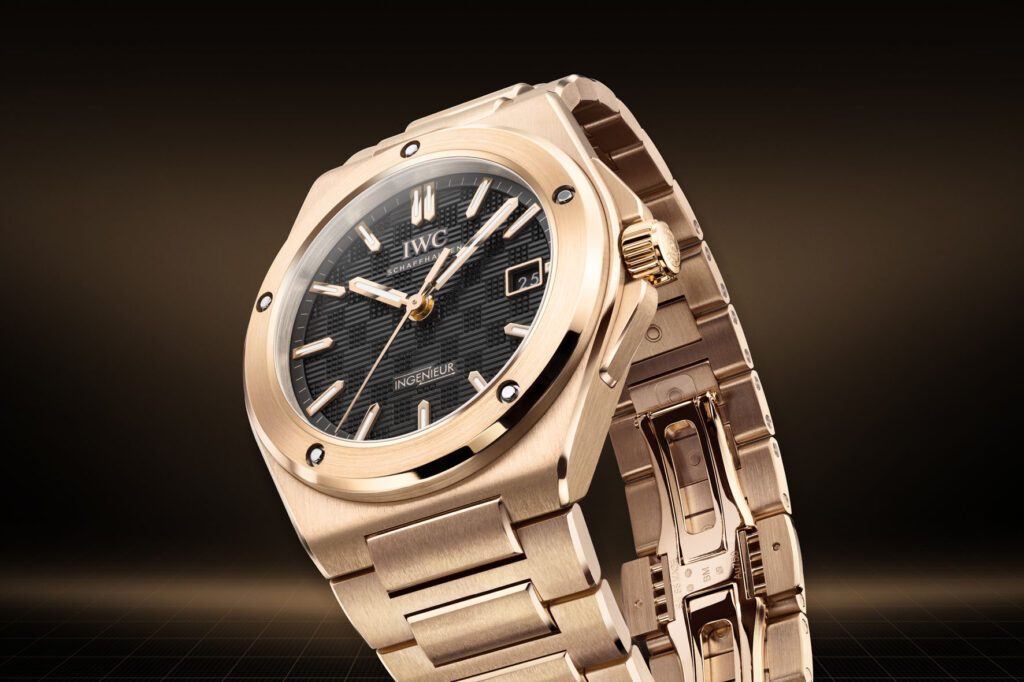
As on the other references in the collection, the bezel is held in place by five functional screws. This Ingenieur Automatic 40 also has a black dial with a ‘Grid’ structure, on which the solid gold 5N indices are individually hand-applied. Both the indices and the gold-plated hands are filled with Super-LumiNova to ensure excellent legibility in all light conditions.
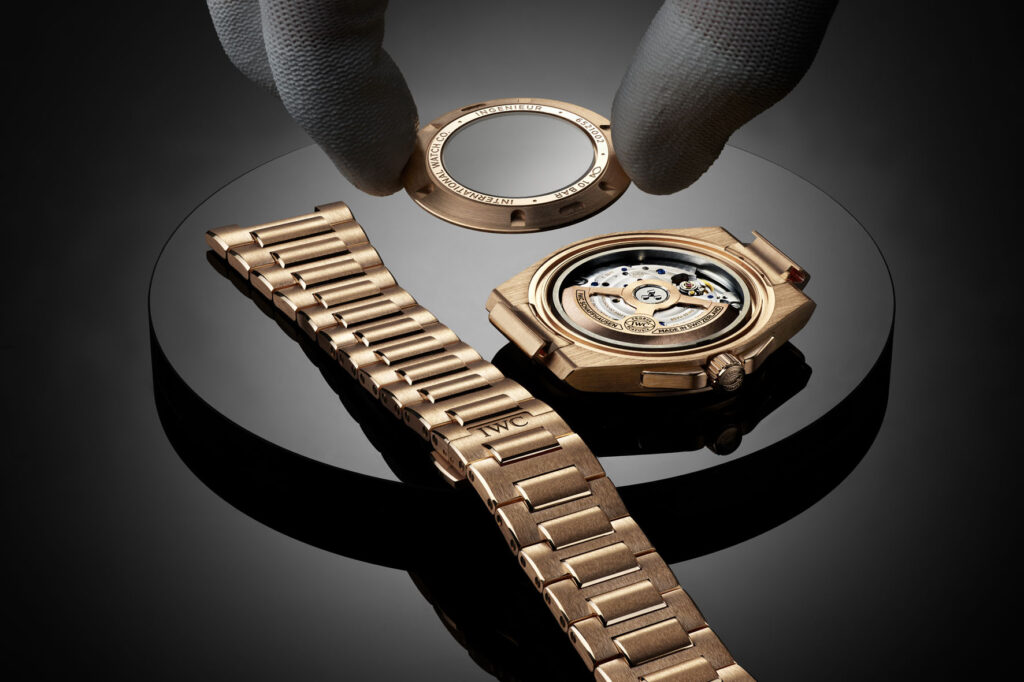
What really makes this reference stand out is the finish of the 5N 18-carat gold, for which IWC Schaffhausen has achieved an unbelievably fine result through a combination of satin-finished and polished surfaces. Indeed, the bezel is satin-finished with polished outer edges, while the casing-ring is polished. The satin finish is also found on the integrated bracelet links, both on the H-shaped links and on the centre links.
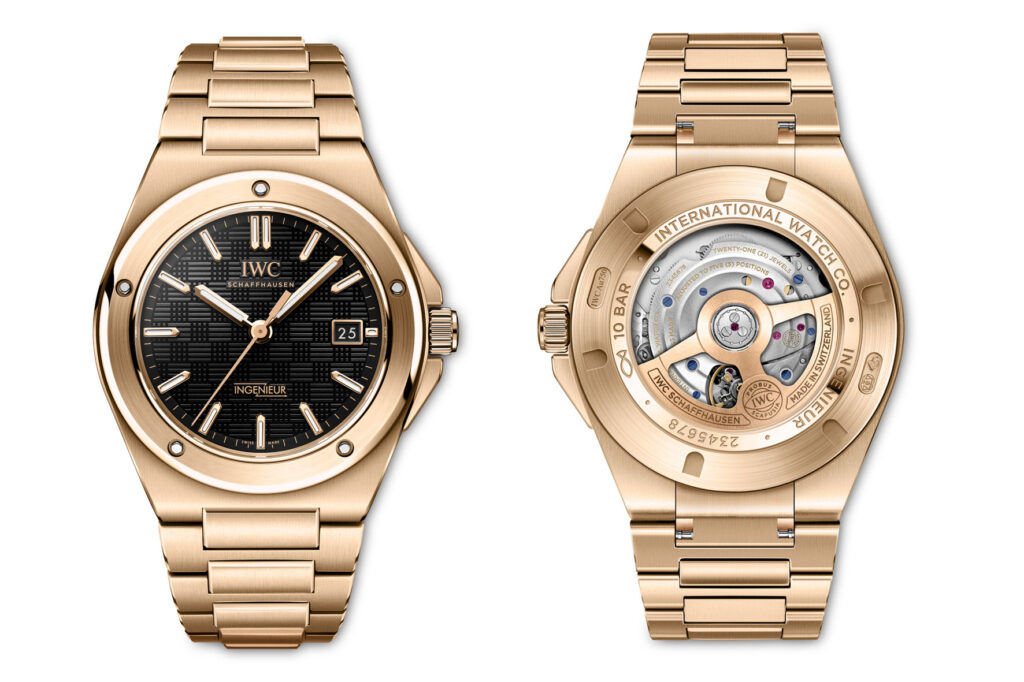
For this Ingenieur Automatic 40 in 18-carat 5N gold, the manufactory chose a sapphire-glass caseback that highlights the calibre 32111 with its double-pawl winding system. Derived from the 32110 – itself developed on an ETA 2892-A2 base – it is also found on the Aquatimer, Portofino and Pilot’s Watch references. It operates at 28,800 vibrations per hour, for a power reserve of 120 hours. The movement is finished with a circular Côtes de Genève motif, blued screws and a gold-plated oscillating weight.(Price €. 51,800)
INGENIEUR AUTOMATIC 40 APX
A special version of the Ingenieur Automatic 40 presented in Geneva was inspired by the movie ‘F1 The Movie’, due for release in the coming months. In the film, Brad Pitt plays Sonny Hayes, a former driver returning to Formula One in the fictional APXGP team. Pitt-Sonny wears a custom-made watch based on the Ingenieur SL reference 1832, with a green dial, the driver’s signature colour. This watch is the result of a collaboration between IWC Schaffhausen, Brad Pitt and Cloister Watch Company, a design studio specialized in creating custom-made watches from vintage pieces.

From that timepiece, IWC Schaffhausen has created a special edition of the Ingenieur Automatic 40, with a steel case and bracelet. Limited to 1,000 pieces, it has a green dial with a ‘Grid’ motif and gold appliqués, a colour combination similar to the one worn by Hayes in the film. Like the other Ingenieur Automatic 40 references, it is powered by the IWC-manufactured 32111 calibre. Following the Ingenieur tradition, the soft-iron inner case protects the movement from the harmful effects of magnetic fields. (Price €. 14,300)
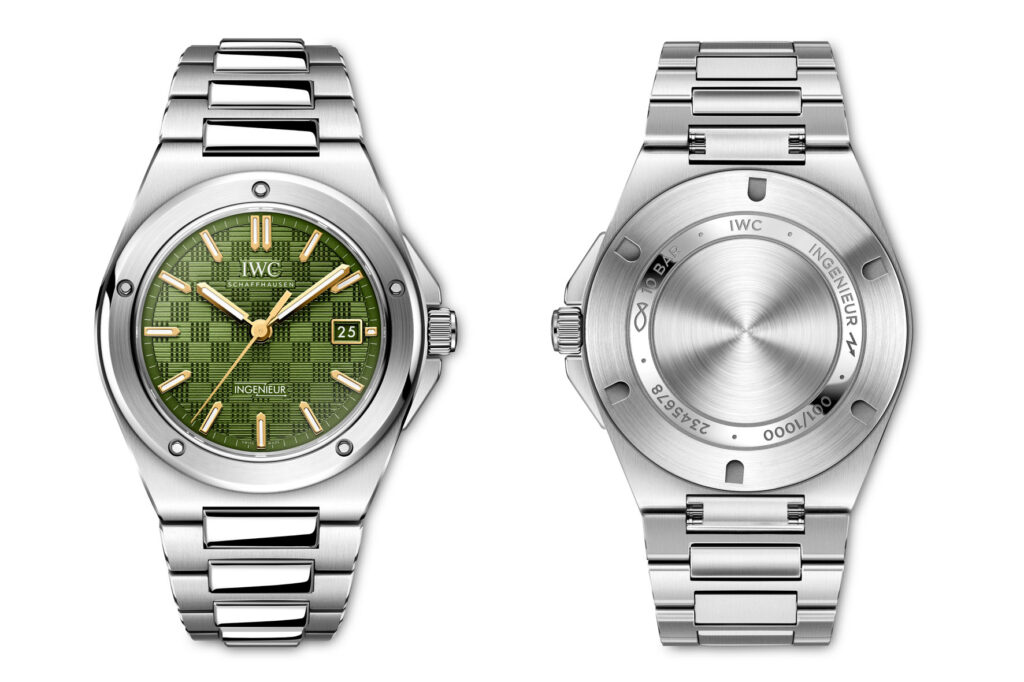
INGENIEUR AUTOMATIC 35
Not just 40 millimetres, though. At this year’s Watches and Wonders Geneva, the Swiss watch manufacturer is expanding its Ingenieur collection with the Ingenieur Automatic 35. This new, more compact automatic model has a case diameter of 35 millimetres and a thickness of just 9.44 millimetres. The Ingenieur Automatic 35 is available in three versions: one with an 18-carat 5N gold case and bracelet and a gold-coloured dial; one with a steel case and bracelet and a silver-coloured dial; and one with a steel case and bracelet and a black dial. (Price €. 11,400).
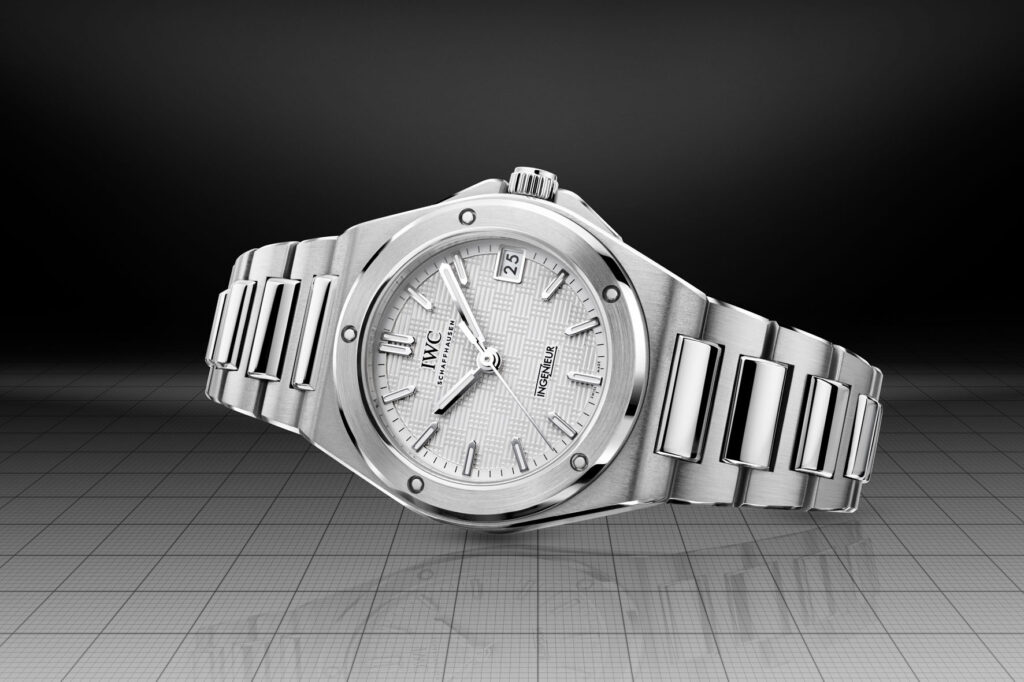
If the 40 mm version was already characterised by an excellent fit, this 35 mm version is even more so. Despite its more compact dimensions, the Ingenieur Automatic 35 has all the characteristic Ingenieur design elements we have already seen on the 40 mm: from the bezel with five functional screws to the integrated bracelet, and the ‘Grid’ dial with applied indices. Designers and engineers have worked hand in hand to define, re-size and finish every part of the Ingenieur in a smaller case. On all three versions we find the same attention to alternating polished and satin finishes as on the 40 mm gold model. Similarly, on the ‘Grid’ dial, the indexes are individually hand-applied.
For the 35 mm model, IWC Schaffhausen also chose a sapphire glass back for all three versions to show the movement in action. In this case, it is the self-winding 47110 calibre, which works at 28,800 vibrations per hour and has a 42-hour power reserve. The finishing is similar to that of the 32111 calibre.
INGENIEUR AUTOMATIC 42 BLACK CERAMIC
Decidedly more interesting: the version of the Ingenieur Automatic 42 with a black ceramic case. A material that IWC Schaffhausen first handled back in the mid-1980s, when it presented the world’s first wristwatch with a black zirconium oxide ceramic case. The company’s engineers continued to innovate in this field and introduced other materials including silicon nitride, boron carbide and coloured ceramic. More recently, the first watch cases made of a ceramic matrix composite were produced.

The case of the Ingenieur Automatic 42 Black Ceramic consists of three parts. Since the bezel and back are attached to the case ring with functional screws, this construction also requires a titanium ring on the inside. It accommodates the screws on the front and back, holds the movement and helps maintain the 10-bar water resistance. Instead of being held in place by the titanium ring, the sapphire crystals on the dial and back are pressed directly into the ceramic parts. In this way, the manufactory has maintained the Ingenieur’s characteristic proportions and shapes, while guaranteeing its structural integrity and water resistance.
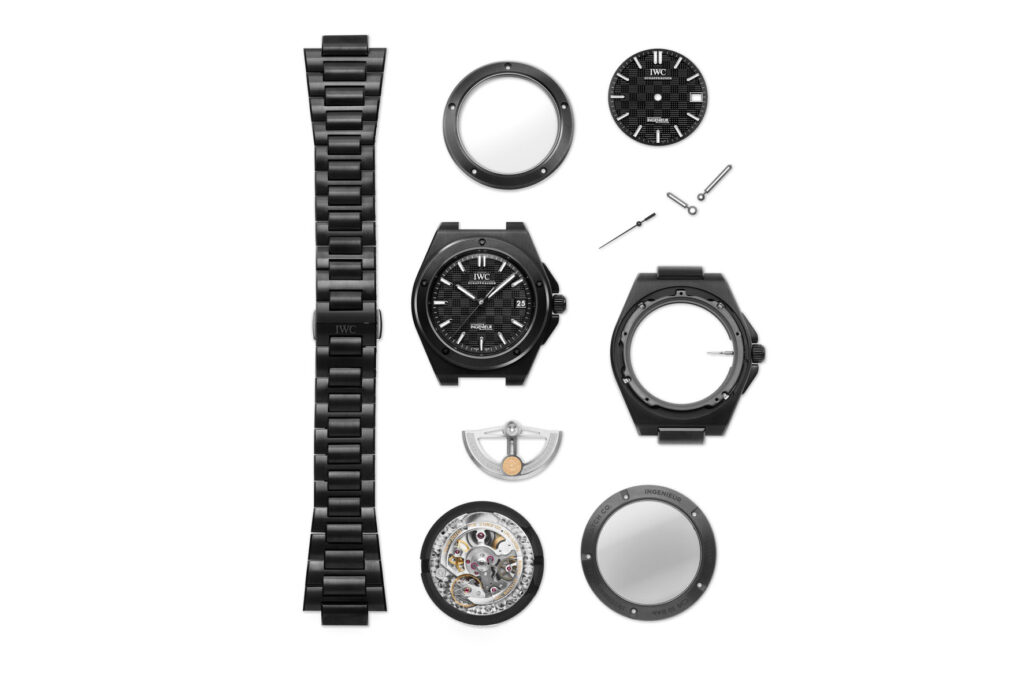
It is the first time that the Ingenieur Automatic 42 Black Ceramic presents the integrated bracelet derived from Gérald Genta’s design and made entirely of ceramic. The same material is found on the casing-ring, bezel and crown. Thanks to the lightness of the material, the integrated bracelet gives a comfortable feeling on the wrist. On the black dial with its ‘Grid’ structure, IWC Schaffhausen has not opted for tone-on-tone for the hands and indices, but has coated them with Super-LumiNova, favouring legibility over aesthetics.
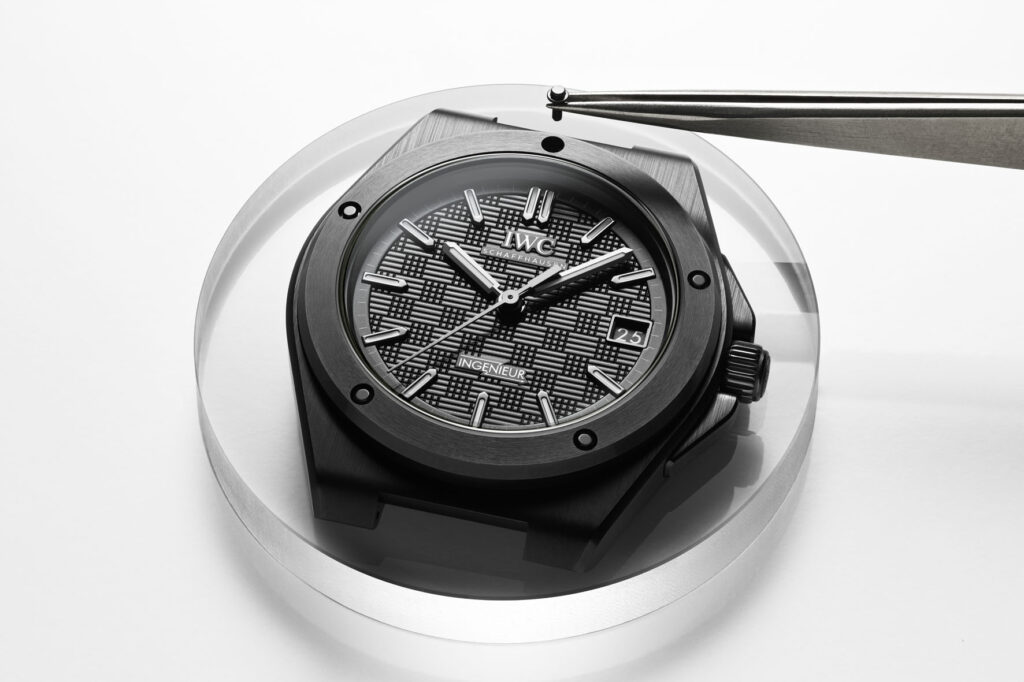
With a hardness of around 1300 Vickers, zirconium oxide ceramic is among the hardest materials on earth and can only be machined with diamond-tipped tools. For this reason, the finish of the Ingenieur Automatic 42 Black Ceramic is the result of exceptional work. The case parts are satin-finished and treated with a smooth sandblasting and polishing around the edges. The bracelet links have the same elaborate surface treatment with a combination of satin-finishing, sandblasting and polishing.
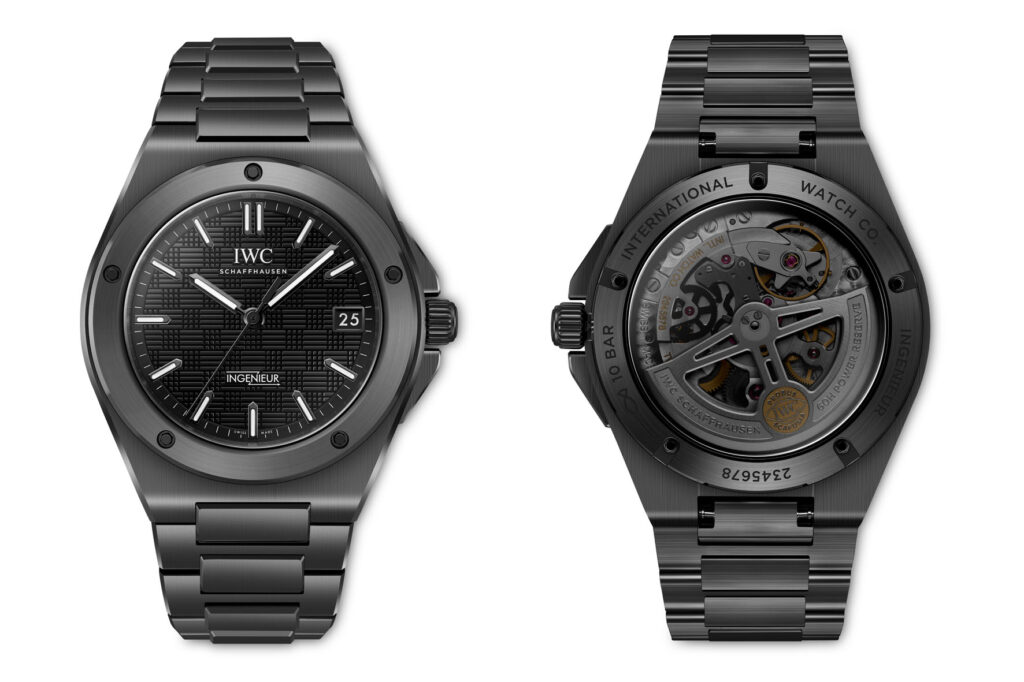
Housed inside the case of the Ingenieur Automatic 42 Black Ceramic is the IWC-manufactured 82110 calibre, one of the most intriguing from IWC Schaffhausen, featuring the Pellaton winding system. It efficiently converts the bi-directional movement of the oscillating weight into energy for the mainspring, building up its 60-hour power reserve. The components of the winding system subjected to high stresses are made of zirconium oxide ceramic, and the balance oscillates at a frequency of 4 Hertz. The movement is visible through the tinted sapphire crystal case back, which complements the all-black design of the watch. (Price €. 21,700)
INGENIEUR PERPETUAL CALENDAR 41
Finally, here is the most valuable piece from the Ingenieur collection that IWC Schaffhausen brought to Watches and Wonders Geneva. Most valuable because it is also the only complication among the new additions to the line: the IWC Ingenieur Perpetual Calendar 41. A complication, the perpetual calendar crown, which was developed in the Schaffhausen watch manufactory by Kurt Klaus and first appeared in 1985 in the Da Vinci Perpetual Calendar Chronograph. Today, it joins the Ingenieur collection.
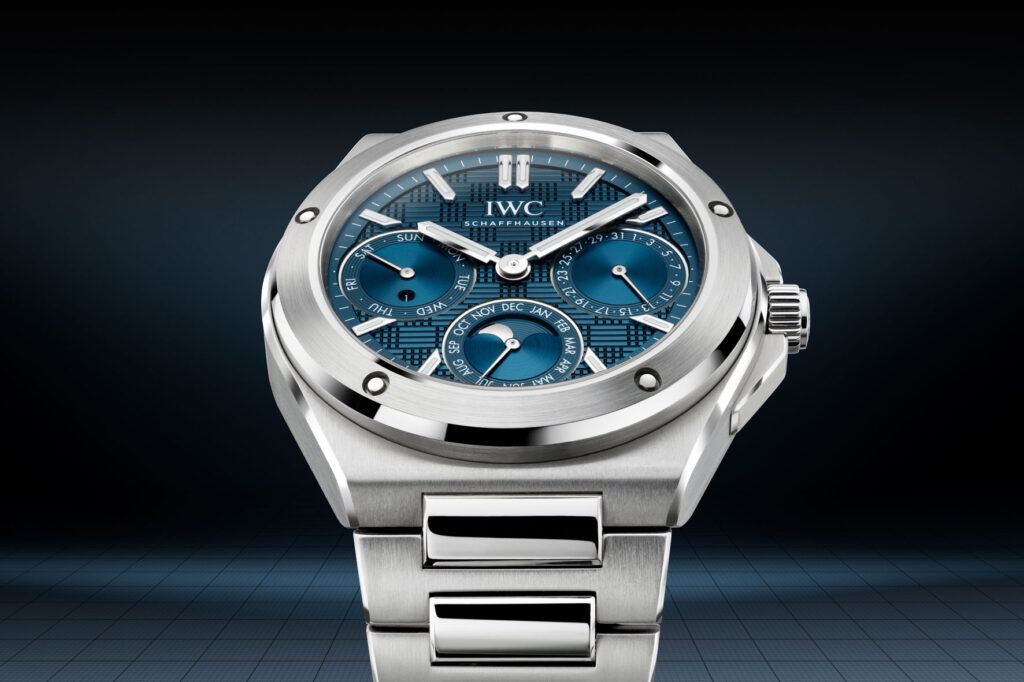
The Ingenieur Perpetual Calendar 41 has a steel case with a diameter of 41 millimetres, the size of which has been reworked and adapted to accommodate the perpetual calendar movement without sacrificing the ergonomics typical of the collection. Ergonomics that, on this model, is accentuated by the integrated bracelet, also in steel, with H links and a butterfly clasp. As for the other references, on this perpetual calendar the case, bezel and crown protection, as well as the bracelet, feature a combination of satin-finished and polished surfaces that illuminate the structure of the dial. It too has a ‘Grid’ structure, interrupted, however, by the presence of the counters worked with a sunray finish – densely textured in the centre and more sparse on the outside – on the ring where the information is displayed. After colouring in light blue, the indications on the calendar counters are displayed thanks to a pad-printing process. The rhodium-plated hour and minute hands are filled with Super-LumiNova, as are the individually hand-applied metallic hour markers.
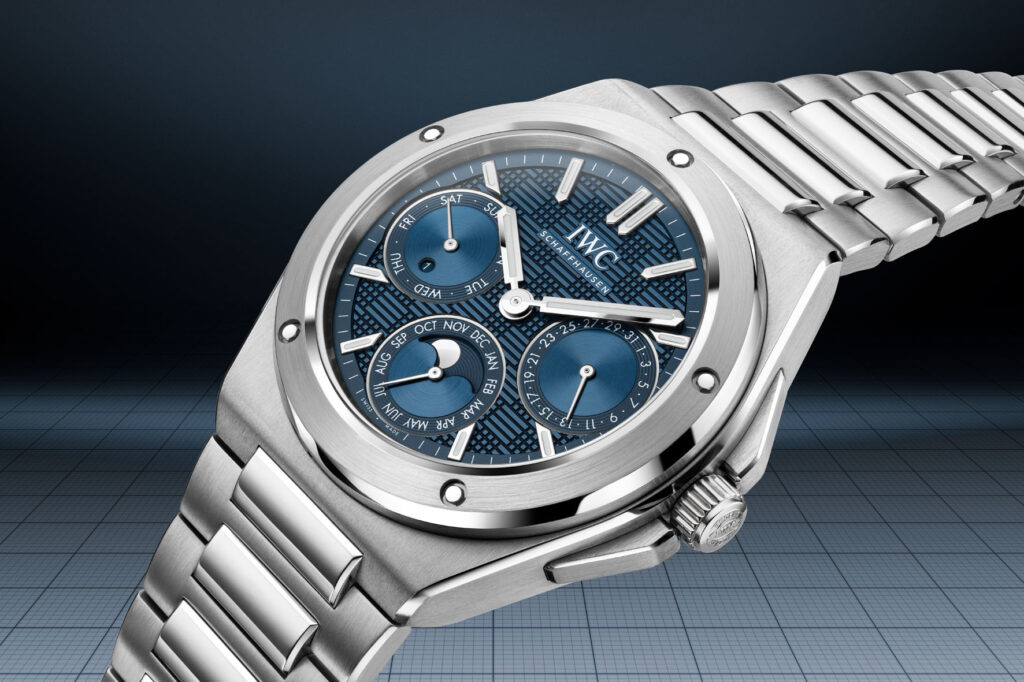
The perpetual calendar indications are adjusted simply by turning the crown, and are entrusted to three counters that are accurately integrated into the dial of the Ingenieur Perpetual Calendar 41, positioned at 3, 6 and 9 o’clock. The dial at 3 o’clock shows the date, while the one at 6 o’clock combines the month with the perpetual, so-called ‘precision’, phases of the moon. This is because, thanks to a reduction train using two intermediate wheels, the moon phase display has a deviation of only one day every 577.5 years. In addition to showing the day of the week, the dial at 9 o’clock has a small window at the bottom to display the years until the next leap year. In the event of a leap year, the calendar automatically inserts a 29th day at the end of February.
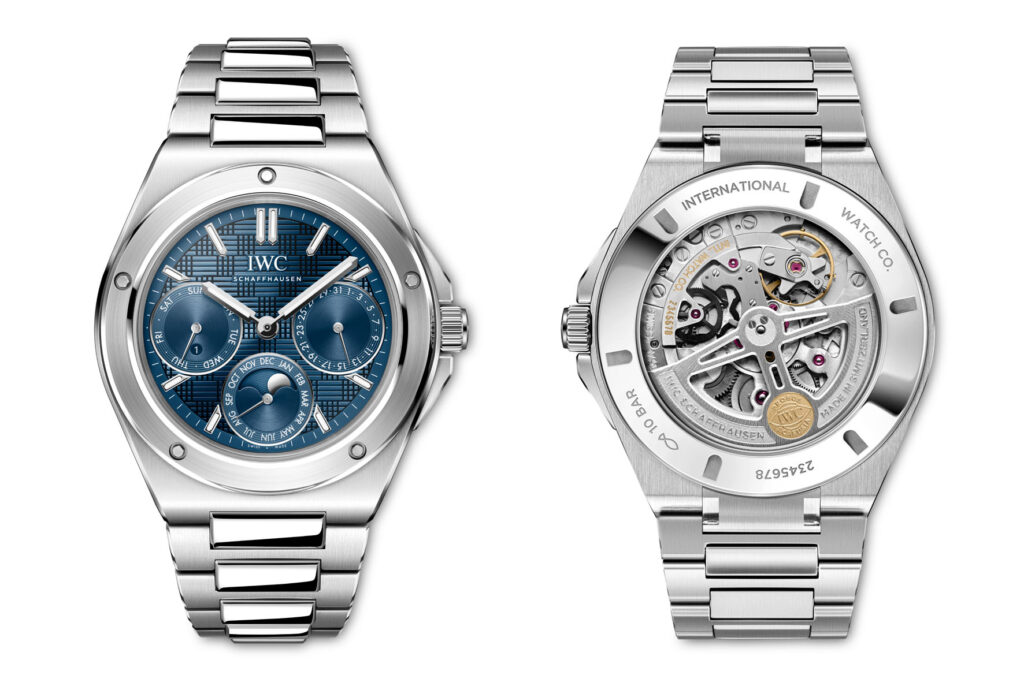
The Ingenieur Perpetual Calendar 41 is powered by the IWC-manufactured 82600 calibre, developed by IWC Schaffhausen on the basis of the 82200 calibre. It features the Pellaton automatic winding system we have seen inside the ceramic reference. To increase its resistance, the Swiss watch manufacturer has made the components subject to high stress in zirconium oxide ceramic, a material that is practically wear-free. Thus, the automatic wheel is made of black ceramic, while the rotor bearing is white ceramic. These features are visible through the sapphire crystal case back, which enhances the circular Côtes de Genève finishing and the use of blued screws. (Price €. 41,200)
By Davide Passoni

